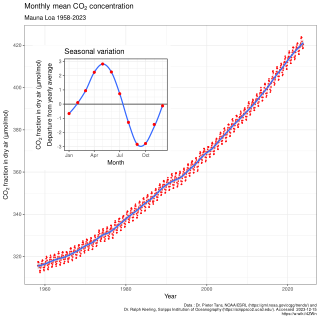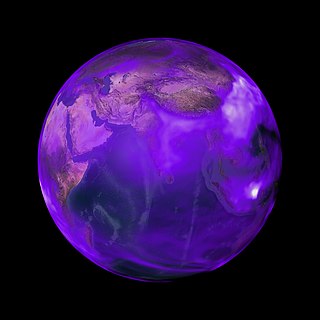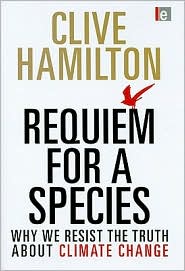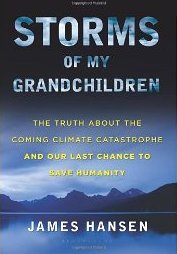
The global warming controversy concerns the public debate over whether global warming is occurring, how much has occurred in modern times, what has caused it, what its effects will be, whether any action can or should be taken to curb it, and if so what that action should be. In the scientific literature, there is a strong consensus that global surface temperatures have increased in recent decades and that the trend is caused by human-induced emissions of greenhouse gases. No scientific body of national or international standing disagrees with this view, though a few organizations with members in extractive industries hold non-committal positions, and some have tried to persuade the public that climate change is not happening, or if the climate is changing it is not because of human influence, attempting to sow doubt in the scientific consensus.

Stephen Henry Schneider was Professor of Environmental Biology and Global Change at Stanford University, a Co-Director at the Center for Environment Science and Policy of the Freeman Spogli Institute for International Studies and a Senior Fellow in the Stanford Woods Institute for the Environment. Schneider served as a consultant to federal agencies and White House staff in the Richard Nixon, Jimmy Carter, Ronald Reagan, George H. W. Bush, Bill Clinton, George W. Bush and Barack Obama administrations.

There is a strong scientific consensus that the Earth is warming and that this warming is mainly caused by human activities. This consensus is supported by various studies of scientists' opinions and by position statements of scientific organizations, many of which explicitly agree with the Intergovernmental Panel on Climate Change (IPCC) synthesis reports.
This glossary of climate change is a list of definitions of terms and concepts relevant to climate change, global warming, and related topics.

James Edward Hansen is an American adjunct professor directing the Program on Climate Science, Awareness and Solutions of the Earth Institute at Columbia University. He is best known for his research in climatology, his 1988 Congressional testimony on climate change that helped raise broad awareness of global warming, and his advocacy of action to avoid dangerous climate change. In recent years he has become a climate activist to mitigate the effects of global warming, on a few occasions leading to his arrest.

Roger Randall Dougan Revelle was a scientist and scholar who was instrumental in the formative years of the University of California, San Diego and was among the early scientists to study anthropogenic global warming, as well as the movement of Earth's tectonic plates. UC San Diego's first college is named Revelle College in his honor.

Chemically, black carbon (BC) is a component of fine particulate matter. Black carbon consists of pure carbon in several linked forms. It is formed through the incomplete combustion of fossil fuels, biofuel, and biomass, and is one of the main types of particle in both anthropogenic and naturally occurring soot. Black carbon causes human morbidity and premature mortality. Because of these human health impacts, many countries have worked to reduce their emissions, making it an easy pollutant to abate in anthropogenic sources.

In common usage, climate change describes global warming—the ongoing increase in global average temperature—and its effects on Earth's climate system. Climate change in a broader sense also includes previous long-term changes to Earth's climate. The current rise in global average temperature is more rapid than previous changes, and is primarily caused by humans burning fossil fuels. Fossil fuel use, deforestation, and some agricultural and industrial practices increase greenhouse gases, notably carbon dioxide and methane. Greenhouse gases absorb some of the heat that the Earth radiates after it warms from sunlight. Larger amounts of these gases trap more heat in Earth's lower atmosphere, causing global warming.

Are We Changing Planet Earth? and Can We Save Planet Earth? are two programmes that form a documentary about global warming, presented by David Attenborough. They were first broadcast in the United Kingdom on 24 May and 1 June 2006 respectively.

The Virgin Earth Challenge was a competition offering a $25 million prize for whoever could demonstrate a commercially viable design which results in the permanent removal of greenhouse gases out of the Earth's atmosphere to contribute materially in global warming avoidance. The prize was conceived by Richard Branson, and was announced in London on 9 February 2007 by Branson and former US Vice President Al Gore.

The Weather Makers: The History and Future Impact of Climate Change is a 2005 book by Australian scientist Tim Flannery. It discusses climate change, its scientific basis and effects, and potential solutions.

References to climate change in popular culture have existed since the late 20th century and increased in the 21st century. Climate change, its impacts, and related human-environment interactions have been featured in nonfiction books and documentaries, but also literature, film, music, television shows and video games.

Carbon dioxide in Earth's atmosphere is a trace gas that plays an integral part in the greenhouse effect, carbon cycle, photosynthesis and oceanic carbon cycle. It is one of several greenhouse gases in Earth's atmosphere that are contributing to climate change due to increasing emissions of greenhouse gases from human activities. The current global average concentration of CO2 in the atmosphere is 421 ppm as of May 2022. This is an increase of 50% since the start of the Industrial Revolution, up from 280 ppm during the 10,000 years prior to the mid-18th century. The increase is due to human activity. Burning fossil fuels is the main cause of these increased CO2 concentrations and also the main cause of climate change. Other large anthropogenic sources include cement production, deforestation, and biomass burning.
This is a list of climate change topics.
The Cornwall Alliance for the Stewardship of Creation is a conservative Christian public policy group that claims that a free-market approach to care for the environment is sufficient, and is critical of much of the current environmental movement. The Alliance is "engaged in a wide range of antienvironmental activities" and in particular denies man-made global warming. Originally called the "Interfaith Stewardship Alliance" it was founded in 2005 in reaction to the efforts of evangelical leaders to fight global warming. The name Cornwall came from the 2000 Cornwall Declaration. The organization's views on the environment have been strongly influenced by the wise use movement of the 1980s and 1990s.

The history of the scientific discovery of climate change began in the early 19th century when ice ages and other natural changes in paleoclimate were first suspected and the natural greenhouse effect was first identified. In the late 19th century, scientists first argued that human emissions of greenhouse gases could change Earth's energy balance and climate. Many other theories of climate change were advanced, involving forces from volcanism to solar variation. In the 1960s, the evidence for the warming effect of carbon dioxide gas became increasingly convincing. Some scientists also pointed out that human activities that generated atmospheric aerosols could have cooling effects as well.

350.org is an international environmental organization addressing the climate crisis. Its stated goal is to end the use of fossil fuels and transition to renewable energy by building a global, grassroots movement.
The Weather of the Future: Heat Waves, Extreme Storms, and Other Scenes From a Climate-Changed Planet (ISBN 978-0-06-172688-0) is a 2010 book by climatologist Heidi Cullen. Cullen takes as her starting point the "clear and present dangers" posed by the greenhouse gases which result from the burning fossil fuels. She offers a vision of what life might be like in a warmer world. Cullen predicts "more frequent and more violent storms, more hot spells, cold spells, droughts, famines and huge waves of desperate refugees".

Requiem for a Species: Why We Resist the Truth about Climate Change is a 2010 non-fiction book by Australian academic Clive Hamilton which explores climate change denial and its implications. It argues that climate change will bring about large-scale, harmful consequences for habitability for life on Earth including humans, which it is too late to prevent. Hamilton explores why politicians, corporations and the public deny or refuse to act on this reality. He invokes a variety of explanations, including wishful thinking, ideology, consumer culture and active lobbying by the fossil fuel industry. The book builds on the author's fifteen-year prior history of writing about these subjects, with previous books including Growth Fetish and Scorcher: The Dirty Politics of Climate Change.

Climate restoration is the climate change goal and associated actions to restore CO2 to levels humans have actually survived long-term, below 300 ppm. This would restore the Earth system generally to a safe state, for the well-being of future generations of humanity and nature. Actions include carbon dioxide removal from the Carbon dioxide in Earth's atmosphere, which, in combination with emissions reductions, would reduce the level of CO2 in the atmosphere and thereby reduce the global warming produced by the greenhouse effect of an excess of CO2 over its pre-industrial level. Actions also include restoring pre-industrial atmospheric methane levels by accelerating natural methane oxidation.














